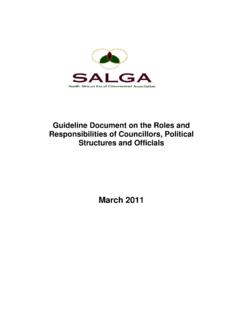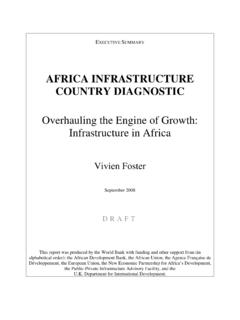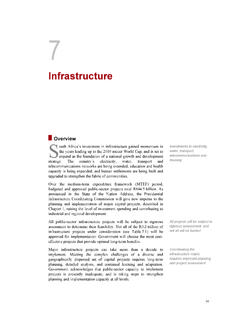Transcription of Municipal Bonds for Infrastructure Development in South …
1 1 Discussion paper Municipal Bonds for Infrastructure Development in South Africa Dr Juergen Goebel GIZ and SALGA May 2017 Contents Foreword .. 2 What are Municipal Bonds ? .. 2 The Green Bond as a Special Type .. 6 What are Their Strengths and Weaknesses? .. 7 How have Municipal Bonds been Doing in the USA? .. 9 The History .. 9 Market Regulation: The Municipal Securities Rulemaking Board (MSRB) .. 10 The Electronic Municipal Market Access (EMMA ) Platform .. 10 Market Performance: The S&P Municipal Bond Index .. 11 How are They Doing in South Africa? .. 14 Regulation .. 14 The Policy Framework for Municipal Borrowing and Financial Emergencies .. 16 Current Debt Policy.
2 18 How Could Municipal Bond Borrowing be Improved in South Africa? .. 22 References .. 24 2 Foreword This discussion paper has been written in the spirit of Action Research 1. Action Research aims at solving an acute social problem by guiding a reflective process of suitable knowledge creation in a system or community of practice. This type of research invites stakeholders for active participation in a social change process. There are thus two processes in inter-connection and inter-action: Knowledge creation social change. The more general problem that we deal with in this discussion paper is the funding of local public Infrastructure in South Africa. There seems to be limited funding; and the given funding seems to be not as fair, equitable, efficient or effective as possible.
3 The more specific question we ask is: How can this problem be solved by Municipal Bonds ? This piece of Action Research has been developed in a cooperation between SALGA and GIZ. Other stakeholders have been included. My thanks go to all of them. However, a specific sustainable solution has not yet been found and implemented from that. The Action Research process thus needs to go on. All stakeholders are still cordially invited to participate. What are Municipal Bonds ? A Municipal bond is a standardized debt instrument, a debt security, issued by a Municipal entity. In the following categories, bond standards may be set: Type of issuer: The issuer can be any type of Municipal entity, as also for instance a school council or a local public water board.
4 Number of issuers: A bond can be issued by one (single) or several (joint or pooled) Municipal entities. In the latter case, the joint issuers need to find arrangements on how they share the o Rights and obligations, o Revenues and expenditures, o Assets and liabilities, and 1 For more see: Burns (2007); Greenwood/ Levin (2007). 3 o Risks that arise out of the joint bond venture. Principal: The principal should be fixed to an amount that is: o high enough so that the relative transaction costs are kept reasonably low; and o low enough so that also lower income citizens can afford to buy a Municipal bond. The total amount of debt can be varied (in multiples) by the number of Municipal Bonds issued.
5 Maturity: A major distinction is made between short term Municipal Bonds (so called notes ) and long term ones. The criterion for notes is one year of maturity, as a maximum. Municipal entities normally use these notes for bridge financing so when they expect to collect some revenue, soon, but need the cash, now. Long-term Bonds are normally integrated into Infrastructure projects. A term of 10 or 30 years is still very common. Coupon: The price for borrowing is the interest. Bonds express their interest claims in coupons. For Municipal Bonds , a coupon for every half a year is a common standard, too. Securitization: There are two main principles of securitization: o General obligation: Principal and interest are secured by the full faith and credit of the borrower, including all its assets and revenues, as there are for municipalities, in particular: charges, fees and property rates.
6 O Project obligation: Principal and interest are secured by the assets and revenues that are generated by the specifically funded ( Infrastructure ) project. The lender is given a priority right on these. All other assets and revenues of the borrower are excluded from that obligation. Use of funds: Here, we distinguish between the following two types: o Free use: The issuer can spend the principal for whatever purpose. o Specific use: The bond stipulates the purposes that the principal is spent for. In a green bond, for instance, the principal is dedicated to specific local public projects with a positive ecological impact [see next subsection]. Taxation: Municipal Bonds are taxable or tax exempt. This distinction can be made with respect to different tax authorities and different tax types.
7 One reason for a bond to be tax exempt is that the benefits that the bond holder generates for the municipality or other public entities are not fully covered by the interest payment. Special options: Municipal Bonds can offer different options to the borrower or to the lender to change the status of the bond during the tenure. For instance, if the Municipal bond is callable, the borrowing Municipal entity is allowed to redeem it, before (stipulated) maturity. Certain standards may be in place as to when and to what degree the Municipal bond can be redeemed. 4 What makes a Municipal bond essentially different from a similarly standardized corporate bond, is the special status of the issuer. Just to remember: A municipality has its own territory.
8 On this territory, the local community gives it a mandate. From that mandate, specific powers and functions are derived. To justify its powers and fulfil its functions, the municipality has to follow specific rules and processes. In an intergovernmental system, these powers and functions, rules and processes become related to other public entities of the same or a different public sphere. Hence, due to this special status, the following aspects can become rather relevant for a Municipal bond: Economic and social Development and planning: The issuance of a Municipal bond should be part of a broader and consistent socio-economic plan by the municipality. Positive externalities: A major task of local government is to provide those goods to the community which generate significant positive externalities, as it is typically the case for Infrastructure .
9 The specific problem with those goods is to generate sufficient own revenue. The power to tax: In order to internalize externalities, the government is given the power to tax. However, citizens might still find ways to avoid or evade taxes. Intergovernmental grants: If also other spheres of government profit from Municipal Infrastructure delivery, it seems easy to justify that they contribute to the cost recovery. However, different entities may have different norms, different incentives, preferences, endowments and information. Hence, there may be an increased risk of misallocation of resources. Public participation: According to democratic principles, a Municipal entity needs to integrate the community into their decision making.
10 The process may thus diverge in form, content and speed from the expectations of a bond market. Social cohesion: The effectiveness of Infrastructure funding and delivery may be highly correlated with the degree of social cohesion in the respective municipality. All these aspects will thus determine the Municipal bond market outcomes. The essential outcomes are: Price; Fluctuation of price; Liquidity/ transaction volumes; Yield/ return. To make Municipal Bonds successful on the market, it needs a highly detailed, structured, skilful and diligent management process. The main players and measures in such a process typically are: Municipal issuer: The municipality first finds out what its financial capital needs are.


















